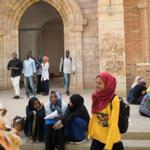‘No race, no tribe’: The December revolution’s struggle for an inclusive, national identity
Ethnic conflicts have been exacerbated by the war in Sudan. Can the youth bring an end to racism and build a united country?
When the young revolutionaries’ slogan ‘Oh, racist and arrogant one, the whole country is Darfur’ echoed in the streets during Sudan’s December revolution, the youth were not simply voicing their support for Darfur. They were distancing themselves from the Islamist regime and its failure to build a united country and bring an end to racism.
Behind their slogans lies a history of racism and ethnic tensions that have long been part of the social fabric of Sudan and has often led to violence. The revolution sought to quell these tensions, but the ongoing war has reignited them, putting the youth’s vision of unity to the test.
A long history of racism
For decades, Sudanese governments, from independence to Omar al-Bashir’s Islamist regime, have failed to build a sense of national unity. Instead, they have implemented policies that reinforced ethnic divisions, like the Native Administration system, described by many as a colonial tool designed to divide local populations along ethnic lines and govern them indirectly through traditional leaders. These policies promoted a singular identity that marginalized large segments of Sudanese society. As a result, ethnic conflicts became part of Sudanese reality.
The youth participating in the December revolution firmly rejected the legacy of previous regimes, striving to build a more inclusive and just society. Their resistance extended far beyond slogans calling for an end to racism, like ‘No racism, no tribalism’. It was expressed through art and activism, and through community initiatives like a 2021 car rally starting in Nyala. People from cities all over the country, including from Khartoum, participated. Engaged youth organized dialogue meetings and wrote articles addressing racism.
The youth participating in the December revolution firmly rejected the legacy of previous regimes, striving to build a more inclusive and just society.
Having often been sidelined by traditional political structures and parties, the young activists formed resistance committees that became key actors in the protests that eventually succeeded in ousting the president Omar al-Bashir. The resistance committees brought their slogans against racism to the protests and sit-ins at the squares of Khartoum — but it didn’t stop there. Their reckoning with the past was also formally reflected in the political declaration of the Wad Madani resistance committees, which focused on peace. These committees, part of a broader nationwide network, critically addressed the legacy of the Native Administration system. This critique was later reinforced in the Revolutionary Charter for People’s Power — a collective manifesto drafted by resistance committees across Sudan — which prioritized peace and embraced the country’s ethnic and cultural diversity as essential for building a more inclusive and just society.
However, divisions soon emerged within these committees. While some saw the civilian forces -FFC - as abandoning the principles of the revolution and its core values of justice, others accused fellow committee members of aligning with specific political agendas. Despite these internal tensions, the resistance committees continued their fight for peace and justice, holding firmly to the ideals of the revolution and embracing Sudan’s ethnic and cultural diversity. However, the transitional government that followed the ousting of the Islamist regime also failed to fulfill the revolution’s demands, continuing the legacy of successive Sudanese governments in sidelining genuine reform and inclusive governance.
Polarization and deepening social rifts
The outbreak of war on 15 April 2023 shattered the fragile unity that the revolution had begun to forge. As violence spread, ethnic identities resurfaced as a primary source of identity and security, leading to a division among Sudanese youth and eroding the solidarity that only a few years ago made them come together under the banner of the revolution. Some of them have sided with the Sudanese Armed Forces (SAF), fighting under the banner of the army whilst proudly boasting the names of their ethnic groups, such as groups from Nuba or the Beja. The Joint Protection Force in Darfur has declared its explicit support for the army and represents an extension of ethnic loyalties within the military establishment.
The outbreak of war on 15 April 2023 shattered the fragile unity that the revolution had begun to forge.
Others have sided with the Rapid Support Forces (RSF), also out of ethnic motives, while a third group has chosen neutrality and continued peaceful action. This division has deepened social rifts and led to new animosities.
The division is of course not solely based on ethnic identities. Some have chosen sides based on the belief in a cause. Others have joined one of the warring parties out of fear, seeking safety in the community of their ethnic group.
But no matter what lies behind their choice, the war has eroded the bond that once united Sudanese youth, shifting the lines of conflict to ‘us’ versus ‘them’.
Many of the young people who have been displaced by the war have returned to their areas of origin, finding a source of identity and security but also heightened ethnic polarization. Social media have become a battleground for racist rhetoric, fueling narratives of exclusion and deepening social fractures. Terms with exclusionary connotations, like ‘bastards’, ‘sons of the guest’ and ‘Arabs of the diaspora’, have become commonplace. Ironically, the same regions that are being targeted by this exclusionary rhetoric are the ones most deeply affected by the war.
In an interview with a young man currently displaced to the Northern State, he describes widespread anger towards communities perceived as harboring soldiers from the RSF "People are angry. They believe certain communities are protecting RSF fighters. That’s why there are calls to isolate them — even talk of separating regions." — Young man displaced to Northern Sudan
Amid this chaos, Sudan is experiencing a deepening crisis with the social and economic fabric collapsing. As polarization increases, achieving change, once aspired by revolutionaries, is becoming a more complex task, with each side believing it possesses the best solution for leading to country towards lasting peace.
This shift in rhetoric reflects a growing intolerance that threatens to persist long after the fighting ends. The depth of hatred and division that has begun to take root in Sudanese society, with tribal identities taking on a more intense ethnic character, complicates the opportunities for understanding and dialogue between different groups.
A roadmap for confronting division and building unity
Unless the increasing divisions are addressed, the seeds of conflict will remain. The war has exposed how fragile Sudan’s national identity is, demonstrating how quickly ethnic conflicts can override revolutionary ideals. Even if the war ends, the underlying divisions will not disappear without deliberate efforts to address them. Superficial peace agreements are not enough; genuine reconciliation and justice must be pursued. A roadmap for confronting division and building unity must be drawn with these elements in mind:
- The Sudanese authorities must make determined efforts to combat all forms of ethnically or exclusionary discourse against any group, through clear policies and effective legislation. The authorities must also seek good working relationships with the media and educational institutions to promote values of diversity and tolerance.
- It is essential for leadership figures to refrain from using ethnically charged language, as it fuels tensions and deepens societal divisions.
- It must be emphasized that the conflict is not with citizens belonging to specific ethnic groups, but rather with militia- the Rapid Support Forces—that exploit ethnic divisions and use racist rhetoric as a pretext to justify their actions and widen the gap between the people of the nation.
- It should be understood that ending the war does not simply mean silencing the sound of guns. There must be real efforts to address the growing public resentment, as the continued spread of exclusionary discourse could lead to future social explosions—even in the absence of military confrontations.
Sudan’s youth stand at a crossroads. Are they able to confront the racist legacy of their past? Their willingness to stand by their ‘No race, no tribe’ slogan will be the litmus test.
This blog post is written by Fai Farah, an anthropological researcher who focuses on identity, diversity, and conflict. It is part of a series focusing on different aspects of youth’s responses to the war, and on the crucial role they can play in pushing for and building sustainable peace in Sudan. The series is the outcome of a SNAC workshop that brought together a large group of SNAC fellows and young Sudanese researchers and activists.
The views expressed in this post are those of the author, and do not necessarily reflect the opinions of the SNAC project or CMI.
.




